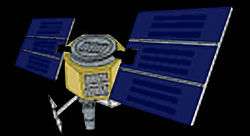Explorer 60
Explorer 60, also called as SAGE, Stratospheric Aerosol and Gas Experiment and AEM-2 (Applications Explorer Mission 2), was a NASA scientific satellite launched on February 18, 1979, from Wallops Flight Facility board a Scout D rocket.
 Explorer 60 (SAGE). | |
| Mission type | Earth science |
|---|---|
| Operator | NASA |
| COSPAR ID | 1979-013A[1] |
| SATCAT no. | 11270[2] |
| Spacecraft properties | |
| Launch mass | 148.7 kg (328 lb) |
| Start of mission | |
| Launch date | 18 February 1979, 16:18 UTC[3] |
| Rocket | Scout D S202C[4] |
| Launch site | Wallops LA-3A |
| End of mission | |
| Last contact | 7 January 1982 |
| Decay date | 11 April 1989 |
| Orbital parameters | |
| Reference system | Geocentric |
| Regime | Low Earth |
| Eccentricity | 0.0008221[5] |
| Perigee altitude | 146 km (91 mi)[5] |
| Apogee altitude | 156 km (97 mi)[5] |
| Inclination | 54.9130°[5] |
| Period | 117.29 minutes[5] |
| RAAN | 268.5781°[5] |
| Argument of perigee | 279.9550°[5] |
| Mean anomaly | 81.0907°[5] |
| Mean motion | 16.45579885[5] |
| Epoch | 11 April 1989[5] |
| Revolution no. | 56056[5] |
Spacecraft and Mission

Explorer 60 was developed and built at the Boeing Aerospace consisting of two distinct modules: the spacecraft base module and the instrument module. The base module is a small, hexagonal prism containing power, command, communications, data handling and attitude control subsystems to support the instrument module. The base module includes a PCM (Pulse-Code Modulation) telemetry data system and a communications subsystem that makes use of a conical log spiral S-band antenna and two VHF antennas.[6]
The base module is spin-stabilized, with 3-axis stabilization provided by an active reaction wheel and a magnetic torquing system (the attitude determination hardware consists of 5 Adcole 2-axis DSS, 2 Hughes HS scanners, and a TAM). The required attitude determination accuracies are: roll 0.7°, pitch 0.5°, and yaw 2.0° in operational mode. A hydrazine orbit adjust system provides the capability to minimize orbit variations to assure adequate mapping by the on-board instrument.
The spacecraft had a launch mass of 148.7 kilograms (328 lb). The base module (six-sided prism) had a height of 65 cm. The overall height of the spacecraft, including antenna, was 1.62 metres (5.3 ft). Power was provided by two solar panels and batteries. Explorer 60 experienced power problems after May 15, 1979. However, the spacecraft operations continued until November 19, 1981. The signal from the spacecraft was last received on January 7, 1982, when the battery failed. On April 11, 1989, the spacecraft decayed in the atmosphere.[6]
Explorer 60 detected and tracked also 5 volcanic eruption plumes that penetrated the stratosphere. It determined the amount of new material each volcano added to the stratosphere.[1]
References
- "SAGE". NSSDC Master Catalog. NASA Goddard Space Flight Center. Retrieved June 22, 2018.

- n2yo.com (2012). "SAGE". Retrieved June 22, 2018.
- "Jonathan's Space Page". Jonathan McDowell. Retrieved 2018-06-22.
- "Explorer". Encyclopedia Astronautica. Mark Wade. Retrieved 2018-06-22.
- Peat, Chris. "SAGE - Orbit". Heavens Above GmbH. Retrieved June 22, 2018.
- "AEM-2". EO-Portal. Retrieved 22 June 2018.
.png)